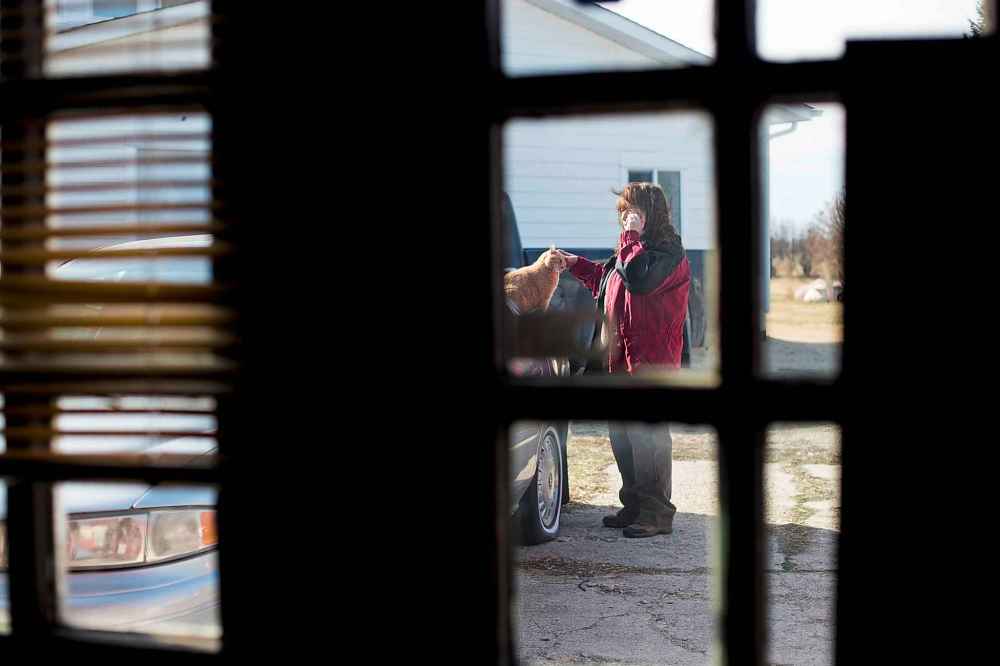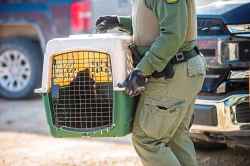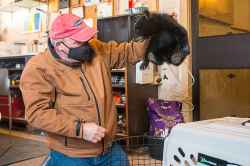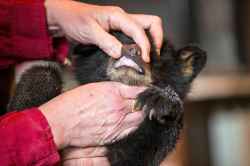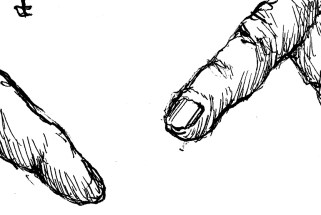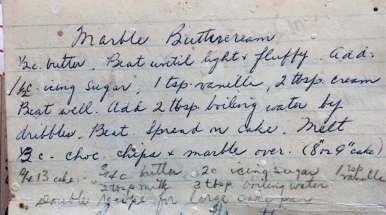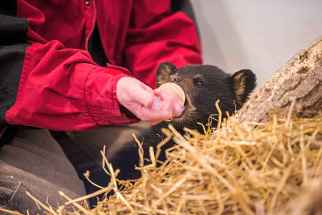The bear necessities Stonewall-area couple are 'cub scout leaders' of sorts who care for orphans until they're ready to survive on their own
Read this article for free:
or
Already have an account? Log in here »
To continue reading, please subscribe:
Monthly Digital Subscription
$0 for the first 4 weeks*
- Enjoy unlimited reading on winnipegfreepress.com
- Read the E-Edition, our digital replica newspaper
- Access News Break, our award-winning app
- Play interactive puzzles
*No charge for 4 weeks then price increases to the regular rate of $19.00 plus GST every four weeks. Offer available to new and qualified returning subscribers only. Cancel any time.
Monthly Digital Subscription
$4.75/week*
- Enjoy unlimited reading on winnipegfreepress.com
- Read the E-Edition, our digital replica newspaper
- Access News Break, our award-winning app
- Play interactive puzzles
*Billed as $19 plus GST every four weeks. Cancel any time.
To continue reading, please subscribe:
Add Free Press access to your Brandon Sun subscription for only an additional
$1 for the first 4 weeks*
*Your next subscription payment will increase by $1.00 and you will be charged $16.99 plus GST for four weeks. After four weeks, your payment will increase to $23.99 plus GST every four weeks.
Read unlimited articles for free today:
or
Already have an account? Log in here »
Hey there, time traveller!
This article was published 21/05/2021 (1667 days ago), so information in it may no longer be current.
Supper is finished, the cats, dogs and horses are fed and Judy and Roger Stearns are about to settle in for a rare evening of Netflix when the phone rings. It’s a call they had been expecting, they just didn’t know when it would come.
“We’ve got a cub for you,” says the voice on the other end of the line.
The television is promptly switched off and the next 12 hours turn into a blur of preparation.
The Stearns have been running Black Bear Rescue Manitoba on their property near Stonewall since 2018. Over that time, the husband-and-wife duo have raised and released 27 orphaned cubs back into the Manitoba wild. It’s an operation filled with equal parts purpose and exhaustion.
Working with wildlife means being on call 24 hours a day, seven days a week. While other animal rescues have staff and droves of volunteers, the black bears have Judy and Roger, both of whom work in Winnipeg. Judy, 55, is a part-time library reference assistant and Roger, 59, is a general superintendent with PCL Construction.
These days, they do have a skeleton crew of volunteers to help out with chores and feeding, but are wary of bringing in too many outsiders for fear habituating the bears to the sights, sounds and smells of humans. This is the first time the Stearns have allowed media onto their property.
Over the next six months, Free Press photojournalist Mikaela MacKenzie and I will be documenting the journey of an orphaned black bear cub named Vinny from his first few hours at the rescue centre through his return to the wilderness, hundreds of kilometres away and some 150 pounds later. This is his origin story.
● ● ●
The Saturday-night phone call from a Manitoba Conservation officer on the last weekend of April marked the official start to the 2021 cub season for Black Bear Rescue Manitoba.
Cottagers in Lac du Bonnet called the provincial tip line — a toll-free number for reporting poachers and wildfires, which is monitored around the clock by conservation staff — when they discovered a fuzzy black bear, smaller than a housecat, camped out under their deck. Its mother was nowhere to be found and after several hours of hopeful waiting, the responding officers trapped the cub and alerted the Stearns.
“They did the smart thing,” Judy says of the cottagers, who also kept their distance from the cub. “If they hadn’t called and waited overnight, it’s like a needle in a haystack; so often, people call about cubs after-the-fact and conservation officers go looking and they’re gone.
“If this little one had wandered away on his own he just would’ve died.”
Despite the stress of being separated from his family, the young cub seemed healthy and alert. He spent the night at the Lac du Bonnet conservation headquarters before taking an hour-long road trip to his new home at the bear rescue early Sunday morning.
For Judy and Roger, the intervening hours were spent cleaning their bear nursery, organizing equipment and sterilizing baby bottles.
“We were out here till midnight,” Judy says. “We always have to be about an hour-and-a-half away from getting ready to accept three to four cubs.”
The calls often come when they’re both at work and sometimes require a roadside handoff with Conservation, depending on where in the province the cub was found; bears have come from as far away as Thompson. Thankfully, schedules are flexible and supervisors are accommodating.

The Stearns bought the 10-acre farmyard near Stonewall 15 years ago with plans to build their dream home. There’s a bunch of old buildings on the property and more than 21,000 square feet (and counting) of space dedicated to the bears, including indoor and outdoor enclosures, food-prep areas and storage facilities.
“We started building the house and the bear enclosure at the same time,” Roger says. “Neither one is finished.”
When a new cub arrives, they spend the first few weeks in a small horse barn-turned-nursery before moving to a covered outdoor enclosure. The stall doors have horseshoe-shaped latches and are outfitted with metal sheets to keep the natural climbers from escaping.
The workshop down the hall is a collision between past and present.
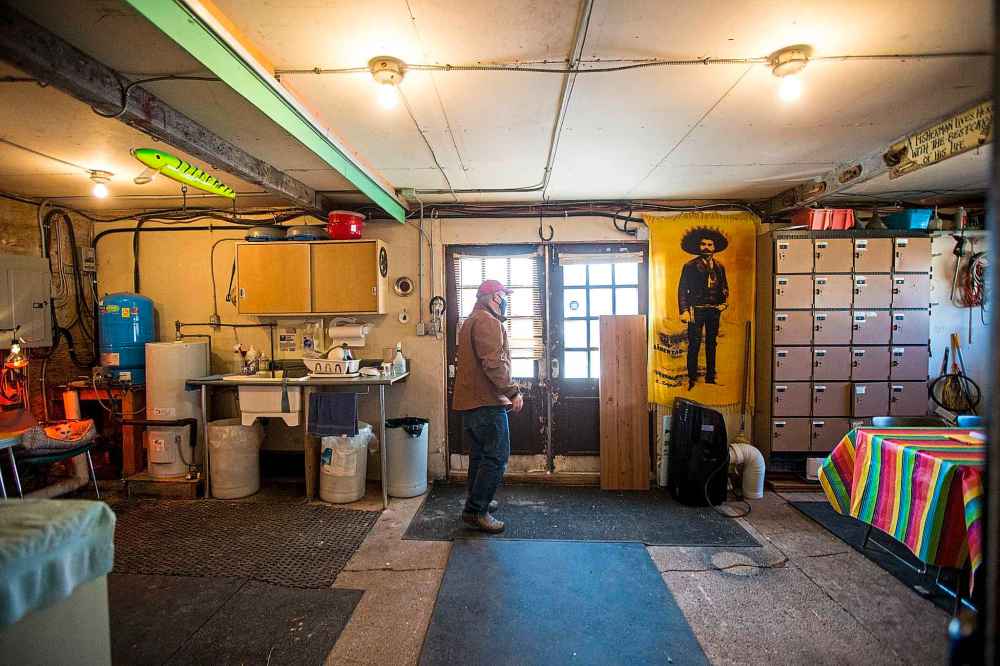
There’s a fridge and a long bank of cabinets filled with bowls, formula, bottle warmers, rubber nipples and feeding charts. There’s a dartboard on one wall and a shelf of papier-mâché dolls on another — Judy’s friends started gifting them as a joke on her 40th birthday and now she’s amassed a collection “she didn’t even really want.” Assorted fishing kitsch is everywhere.
In a previous life, “Le Barn” is where they socialized with friends and hosted New Year’s Eve parties.
“There used to be a margarita machine over there,” Roger says with a chuckle, nodding to the corner where a dour white cat is sitting on a chair under a glowing red heat lamp.
Roger drinks a Pepsi and paces around the room while he waits for the conservation officers to arrive with the Stearns’ new tenant.
● ● ●
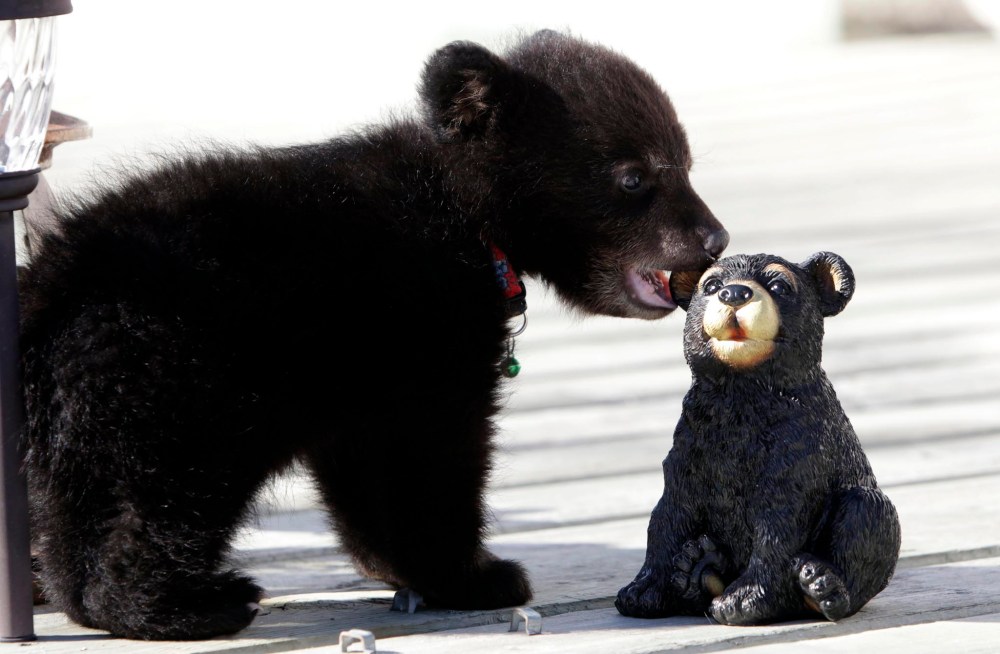
The Stearns have always loved animals, but never imagined they would one day be running a bear rescue.
“We sacrificed lots,” Roger says. “We used to go to Europe every year and I fished a lot; my boat’s hardly getting used. We look at it as, ‘Well, (otherwise) they would have to shoot these cubs.’”
It was the widely publicized story of Makoon that set them on this path.
In 2012, a St. Malo resident found a dying black bear cub in a ditch and nursed the animal back to health in his home. The cub was nicknamed Makoon, which means “little bear” in Cree, and his plight gained international attention when Manitoba Conservation apprehended him from his caretaker.
At the time, there was no bear-rehabilitation program in the province, so the cub was sent to the Assiniboine Park Zoo and released back into the wild several months later — a move decried by the Winnipeg Humane Society and animal advocates, who wanted the cub sent to a rehab centre in Ontario. It’s not known what became of the cub, but Judy assumes the five-month-old, 30-pound animal died in the bush.
“I think he had a very slim chance of surviving,” she says. “I don’t think there were even any berries out when he was released.”
Judy was on the front lines of the conflict; leading protests, launching petitions and managing a Facebook page in Makoon’s honour. She was not satisfied with the story’s conclusion.
“The government should be charged for cruelty to animals,” she told the Free Press in a 2012 article about the cub’s release. “This is not over… I am going to keep going with this and push for changes.”
It was a long process, but she kept her word.
Before they could open Manitoba’s first (and only) black bear rescue, the Stearns had to get a permit from the province. And before they could do that, Judy had to become certified with the International Wildlife Rehabilitation Council, which trains wildlife rehabilitators on the basics of wild animal care. They also had to change the designation of their land, apply for specialized insurance, get support from their neighbours and find a black bear biologist to help the province write new species-specific policies — not to mention hours spent on construction and fundraising.

It’s all been worthwhile knowing orphaned cubs have somewhere safe to land in Manitoba.
“We felt so strongly about the wrong that was done to Makoon that we needed it to be fixed and it prompted us to do this huge lifestyle change,” Judy says. “I worry about a lot of things in the world, I worry about other species, I worry about the environment and this is one thing off my list of worrying.”
● ● ●
It’s just before 10 a.m. when the waiting is interrupted by the sound of tires coming down the gravel driveway. Two uniformed conservation officers step out of the truck and head into the nursery with a large dog kennel in tow.
Roger reaches into the crate and pulls the cub out by the scruff of his neck — the way a mother bear holds her young — to get a closer look at the animal. The cub has downy fur and is almost all black, save for a few light brown whiskers on his chin and ears. He has the size and appearance of a stuffed animal and is totally quiet; likely exhausted by everything he’s been through.
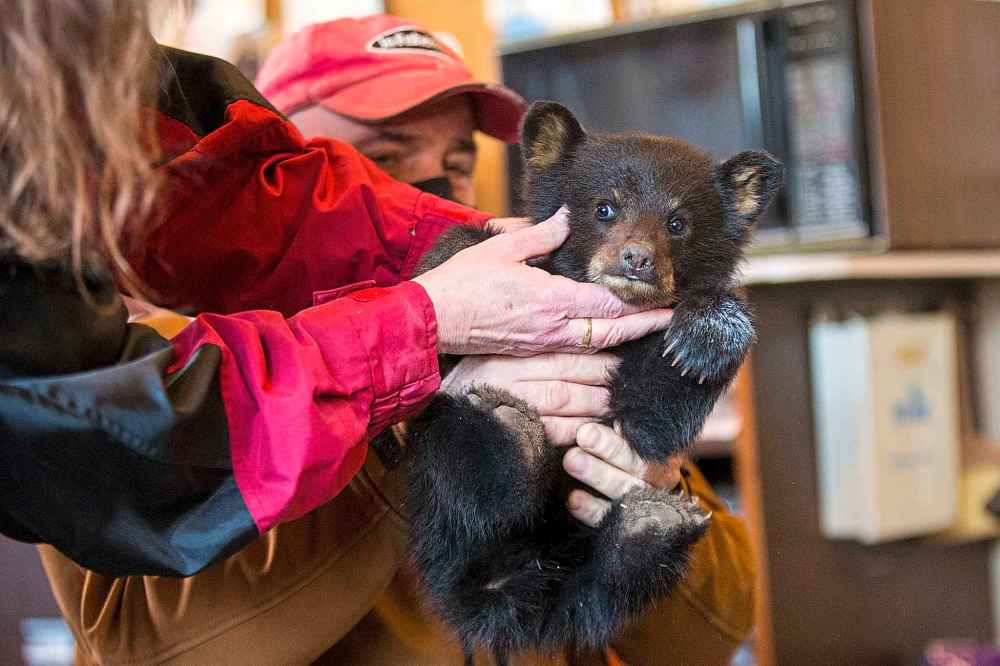
He takes in the strange new environment with wide eyes and submits to the poking and prodding of a basic health scan without complaint. His gums are pink, which rules out anemia, and he doesn’t seem dehydrated.
“He’s really polite,” Roger says. “They’re not all like that.”
He takes the cub over to the weigh scale while Judy launches into her usual line of questioning: Has he eaten anything? No, didn’t touch the water, dates or apple slices that were offered. Is he lethargic or tender? Nope. Have any siblings been sighted? No. Were there any dogs around when you found him (bears can contract diseases, like canine parvovirus, from domestic animals)? None.
“Four point eight pounds,” Roger calls from the hallway.
“He’s really polite. They’re not all like that. ” – Roger Stearns
The cub is about three months old and petite for his age, but by no means the smallest they’ve seen. Last year, the Stearns took in two newborn cubs, Iggy and Izzy, who were the size of just-born puppies. Iggy didn’t survive, but Izzy was released in the fall weighing nearly 188 pounds — Judy and Roger pride themselves on turning out hefty, well-toned animals.
The Stearns’ name their cubs alphabetically and this one will be known as baby bear “V” until he’s given the name Vinny, meaning “to win,” several weeks later — the rescue is a registered charity and cub naming is an honour reserved for donors and supporters. Vinny’s namer made a sponsorship-level donation of $2,000, which will cover the cost of his care through the season.
● ● ●
Black bears give birth in mid-January and commonly have litters of two or three cubs. The family stays in the hibernation den until spring and cubs will stick with their mother, learning to forage and survive, for nearly two years. Orphans are usually the result of encounters with humans.
“Most often it’s because of the fact that the mother died for whatever reason, got killed or hit on the highway,” says Earl Simmons, the province’s chief conservation officer.
In 2018, there were an estimated 25,000 to 30,000 black bears in Manitoba — a population Simmons describes as “extremely stable.” The province allows bear hunting in the spring and fall, but it’s illegal to kill a female with cubs.
“Most often it’s because of the fact that the mother died for whatever reason, got killed or hit on the highway.” – Earl Simmons, the province’s chief conservation officer.
Since orphaned yearlings have a good chance of survival, conservation officers will only take in “cubs of the year,” who are too small to avoid predators and still reliant on their mother for food. They’ll capture the bear using a tranquilizer gun or snare pole, depending on the situation, and get them over to the rescue as soon as possible to reduce their contact with humans.
The relationship between the Stearns and the government’s wildlife branch has warmed considerably since the Makoon controversy. While Vinny settles into the soft straw in his stall, Judy and Roger are eager to talk shop and give the officers a tour around the property.
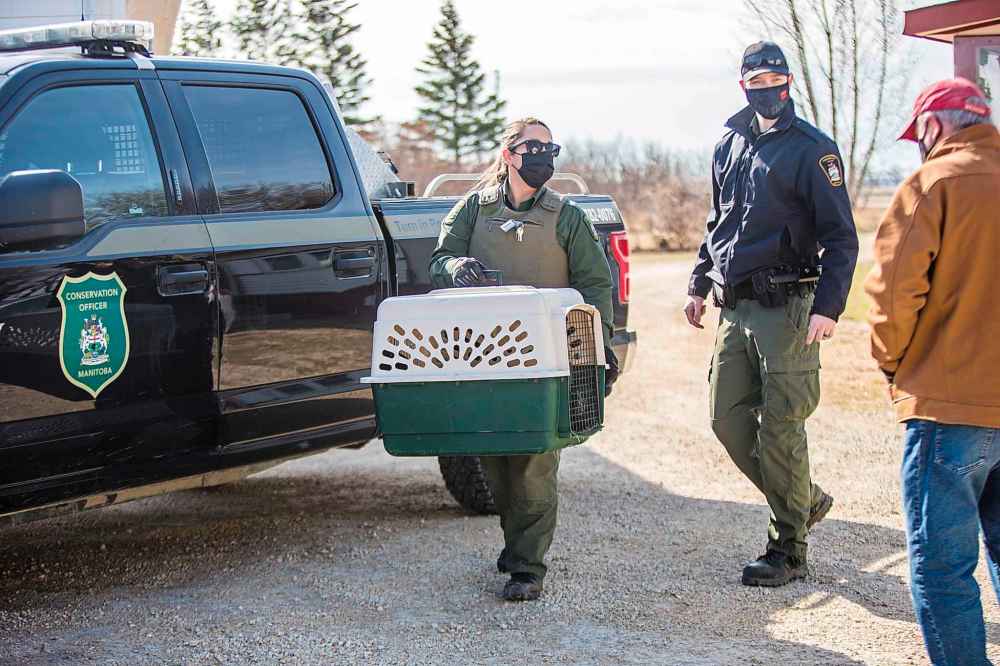
From Simmons’ vantage, partnering with the rescue has been good for the bears and his staff.
“Years back we didn’t have the ability to deal with cubs that were orphaned… and so, we’d end up euthanizing the bear because it would suffer,” he says. “For the conservation officers that go out and rescue these animals so that they have a second chance at life, it’s rewarding to have these kinds of places working with us.”
● ● ●
The officers depart and Judy checks her watch. The vet should be arriving shortly and she needs to be on the road by 12:30 p.m. to make her afternoon shift at the Henderson Library. But first, breakfast.
Roger puts some high-protein formula in a dish to see if Vinny will lap it up before attempting to hand-feed him. The bowl garners no interest, so it’s on to baby bottles and syringes with a special nipple attached. Judy smears some honey on the tip to entice him — turns out Winnie the Pooh isn’t an outlier.
“They love sweets,” Judy says. “And they get in trouble going towards beehives.”
The syringe is a success and they’ll be feeding him small meals every two hours until he moves onto a bottle and later, eating pablum made of kibble and milk. As Vinny grows, his diet will be supplemented with fruits and vegetables.
“We always joke that they’re eating better than we are,” Judy says.

The Stearns try to have as little contact with the cubs as possible, but hand-feeding is unavoidable when they’re used to nursing.
“There’s a misconception with the public that if you handle them at this age, they’re going to be bonded to humans and that’s not true,” Judy says. “And they actually need to be handled if they’re a nervous little insecure animal like this one with no siblings, he might need a bit of nurturing.”
As per the rescue’s permit, each new cub needs to be seen by a veterinarian within 24 hours of arrival. Justin Rosing is used to treating pets and large farm animals out of the nearby Woodlands Veterinary Clinic, but bears are a whole new world.
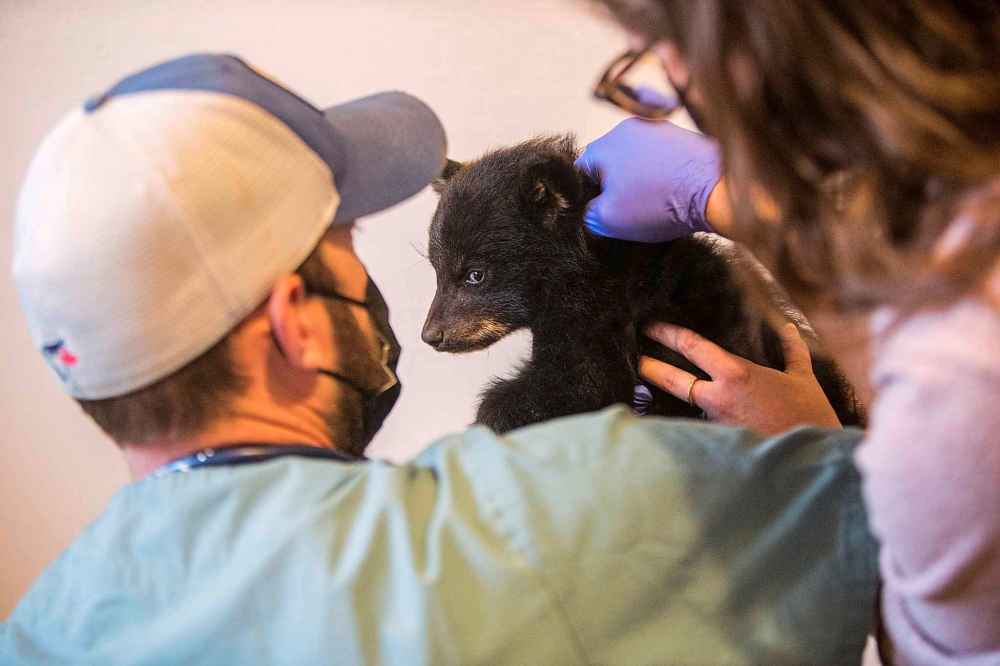
“It’s an adventure because they’re very different,” says Rosing, who has arrived from another call wearing a scrub top, jeans and cowboy boots. “For all our common species we have lots of research, lots of approved products… whereas with bears, there’s no established safe dosages or anything like that.”
The local vet team has been able to tap into the Stearns’ international network of bear health and nutrition experts for guidance.
During the visit, Rosing checks Vinny for injuries, illness and hydration. He administers subcutaneous fluids and prescribes a round of deworming medication as a precaution.
“The most important thing for the bear right now is to get it eating, get it drinking,” he says. “This one is actually a pretty good story, but sometimes they’re alone for a week or longer or emaciated… (but) they do very well in this setting. They’re incredibly resilient.”
Roger jots down the vet’s directions, as well as the cub’s general condition and feeding schedule, in a yellow Duotang folder.
● ● ●
He may have started this journey alone, but Vinny is soon joined in the nursery by three more cubs. His bunkmate Wrigley was also found in the Lac du Bonnet area; however, the Winnipeg man who discovered him is facing charges under the Wildlife Act for taking the male cub to his home.
It’s impossible to know if the cubs are related, but after a 10-day quarantine they’re getting along well. Vinny has nearly doubled his weight and is turning into a feisty little alpha bear, while Wrigley seems content going with the flow.
“Wrigley is more easygoing and Vinny is kind of the more assertive one, he seems to win the wrestling matches more,” Judy says. “They’re best friends now, they’re either eating, playing or sleeping.”
In the next stall over, two sister cubs from Gypsumville are getting reacquainted after their mother was killed by a vehicle. Conservation officers are still searching for a third sibling that was spotted in the area.
“Wrigley is more easygoing and Vinny is kind of the more assertive one, he seems to win the wrestling matches more. They’re best friends now, they’re either eating, playing or sleeping.” – Judy Stearns
There’s no telling how many cubs will make the rescue their home this year. Last season, the Stearns took in a record 19 bears. It’s been a busy few weeks getting the centre ready for summer and somehow Judy’s to-do list continues to grow.
“You try to get as much as you can done and then my darn job gets in the way,” she says with a laugh.
Despite the long days and precious few moments to herself, she wouldn’t have it any other way.
“Roger and I have had a lot of years of having fun and doing what we want,” she says. “I miss that old life, but this is a fantastic thing to sacrifice that for, because it’s fun, too. It’s just different.”
eva.wasney@freepress.mb.ca
Twitter: @evawasney
What to do if you spot an orphaned cub
The best thing you can do for a lone black bear cub is stay away and call for help. The fewer interactions a bear has with humans, the less likely it is to become habituated and lose its healthy fear of people.
Do not approach or attempt to pick up the cub or cubs. Instead, take photos and monitor them from a distance while keeping an eye out for the mother — bears can leave their cubs for hours at a time while they search for food.
The best thing you can do for a lone black bear cub is stay away and call for help. The fewer interactions a bear has with humans, the less likely it is to become habituated and lose its healthy fear of people.
Do not approach or attempt to pick up the cub or cubs. Instead, take photos and monitor them from a distance while keeping an eye out for the mother — bears can leave their cubs for hours at a time while they search for food.
In the meantime, call your local Manitoba Conservation district office or the toll-free provincial TIP (Turn in Poachers) Line at 1-800-782-0076, where staff will determine the best course of action. You can also call or text Black Bear Rescue Manitoba directly at 204-461-4320.
Avoiding bear encounters altogether can benefit cubs in the long run.
Bears are hungry when they come out of hibernation and will take the path of least resistance to get a meal, that often means taking advantage of human carelessness. Bird feeders filled with seeds are a tasty gateway snack.
“Birds don’t need to be fed in the summertime or springtime because there’s all kinds of feed for them in the wild,” says Earl Simmons, Manitoba’s Chief Conservation Officer. “It causes us a lot of grief because bears can get a pile of calories from the bird seeds… they’ll teach the young the same thing, to feed on that, so they’ll get used to being around humans because they know the food’s there.”
Feeders can be used in the winter, but should be put away during the spring, summer and fall.
Bears who are comfortable around people may become more brazen, breaking into cabins or rummaging around campsites to get a meal.
“Those unfortunately become problem bears for us,” Simmons says. “There’s some concern (about) what we’re going to do with those bears because they’ve lost all their fear and they’re potentially dangerous for the public.”
Visit gov.mb.ca/fish-wildlife for more tips on avoiding wildlife interactions.
— Eva Wasny


Our newsroom depends on a growing audience of readers to power our journalism. If you are not a paid reader, please consider becoming a subscriber.
Our newsroom depends on its audience of readers to power our journalism. Thank you for your support.
History
Updated on Wednesday, May 26, 2021 2:21 PM CDT: Clarifies the Stearns' day jobs and the rescue's status as a registered charity.












